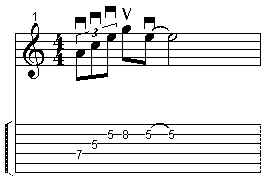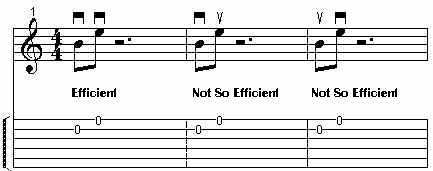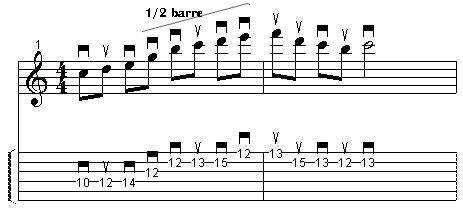Gypsy Jazz Ornaments
/in Guitar Players, Gypsy Jazz Style, Improvising/by Warren SirotaIn an earlier article, “Are You Learning Or Just Copying”, I advanced the idea that ornaments are essential elements of any style, and that copying ornaments from records and applying them to new situations is a great way of evoking the feel of a style.
This observation applies especially to jazz in the style of Django Reinhardt, who utilized ornaments called “enclosures” extensively. In a previous article, we analyzed and reapplied a Wes Montgomery ornament. In this article, we’ll give the same treatment to what I call a variant or two as encountered on recordings. (Turn: An ornament consisting of four or five notes that move up and down ‘around’ a given pitch, using that pitch as a tonal center. It is often referred to as an enclosure.). The first turn is a grace note triplet preceding a “target note” (C, in the following example), like in the first measure of this example:

The second measure shows how the turn is more typically extended and resolved (by continuing the chromatic motion for one more step up, and then continuing with whatever the melody needs to do); so the actual turn is really 5 notes: 3 grace notes and 2 eighth notes.
In practice, Grappelli tends to really play the first triplet as grace notes, while Reinhardt is more likely to steal more time from the preceding note.
For instance, in the version of “Nuages” on Django Reinhardt: Verve Jazz Masters 38, Grappelli plays the third and fourth phrases like this:

In this case, the A in the third measure is preceded by three grace notes (not shown): Bb – B – Bb.
Here’s another example of the trill, from the beginning of Night and Day’s head, from the same CD. This time Django is playing:

In this case, the three grace notes have been expanded to take up a full beat (I’m exaggerating, and the true timing is somewhere between these two extremes). But the form remains the same: it’s a turn leading to the G on the fourth beat of the second measure, and then the chromaticism is extended, as the turn continues down to the Gb and back up to the G in the last measure.
Either way, the chromaticism in the turn, totally contemptuous of the key signature, is a large part of what gives it “gypsy” flavor. A more classical turn might keep the same kind of rhythm and shape, but would more likely use notes within the key signature.
So how do you integrate this into your playing?
First of all, a great type of chord progression to use this on would be a gypsy-type version of that old standard, “Bei Mir Bist Du Schein”. This song is, in it’s simplest form, a 3-chord song consisting of just Am, Dm and E7. However, we’ll jazz it up by substituting a progression involving m6 chords for the Am, and adding an F7 at the end of the form just to spruce up the turnaround. Here’s how the chords go in the A section:
| Am6 Bm6 | C6 Bm6 | Am6 Bm6 | C6 Bm6 |
| E7 | E7 | Am | F7 E7 |
Try improvising over that, starting each phrase with the turn starting on various notes. Which starting notes work the best? (my favorites are E, A and C in that order – the notes of the root chord, even when the other chords are sounding). See what you can come up with! And then try integrating the turn into the middle of phrases – that’s when the chromaticism really comes alive.
Mind-Bending Upstroke Exercises
/in Guitar technique, Gypsy Jazz Style, Improvising/by Warren SirotaIf you’re like me, you’ve never paid that much attention to upstrokes. Like many flatpick-wielding guitarists, I’ve concentrated on alternating picking technique for most of my playing life. And that makes sense – it is certainly the most versatile, general purpose technique that there is. You also probably have a smattering of downstroke-based ascending arpeggios in your repertoire (see example 1). If this is all you’ve done, you’ve ignored perhaps 30% of your picking potential. These exercises will start you on the road towards harnessing that potential.
Example 1:

What I’ve found, though, as I’ve delved into the guitar techniques of Django Reinhardt and Jim Hall, are systematic exploitations of the technique known as “sweep picking.” This refers to the technique of eliminating the inefficiencies that alternating picking imposes on you when you change strings. The simplest case: if you were to play two notes in succession on adjacent strings, sweep picking would dictate that you sound both notes with the same direction stroke, while alternate picking would make you move that pick a lot more (example 2).
Example 2:

Sweep picking is not universally applicable – there are many riffs which don’t lend themselves to this technique – but there are some passages that are virtually impossible to play at full speed without it. The basic principle of sweep picking is to put an odd number of notes on each string – typically 1 or 3, as in example 3. Note that having an even (2) number of notes on the top string facilitates the change of pick direction.
Example 3:

In order to fully integrate sweep picking into your playing, your upstrokes must become as powerful, controlled and fluid as your downstrokes. Example 4 will go a long way towards making that happen if you are sure to accent the first note of each triplet and play the other two softly, regardless of where the up and down strokes fall.
Example 4 is
- the key to basic phrasing flexibility
- much longer than it looks (you need to repeat the pattern about 6 times before the cycle is complete)
- both devilishly complicated and quite simple
- not a finger-twister at all, but quite a mind-twister
(Okay, look – maybe it’s easy for you. Then you’re beyond this column. It wasn’t easy for me at first.)
Let’s explain it before playing it. On the surface, the structure is simple: you start out by playing 3 adjacent notes on the 5th string, then move the same pattern up to the 4th, then up to the 3rd, then to the 2nd, “sweeping” the transition from each string to the next with successive downstrokes. You continue this pattern to the 1st string, but only play two notes in order to facilitate a change of direction from ascending to descending. At this point, we start sweeping with upstrokes bridging adjacent strings instead of downstroke. At this point, the accents start to diverge from the note crossings, and you have to mentally track both, emphasizing the first note of each beat (which, in this measure, happens to fall on a downstroke) while being careful to cross strings with un-emphasized upstrokes. This pattern continues down to the 6th string, where two notes are played and the direction reverses again. The G# in measure 3 is usually where I lose it if I’m not paying enough attention – maintaining the correct accents throughout that second ascent, where all the accents occur on upstrokes, can be a challenge. And the challenge continues. Since the string crossings, stroke direction and the emphasis are all moving “out of phase” with one another, this exercise gives you the raw technique that you’ll need to play a wide variety of phrasings using optimal patterns of up-and-down strokes.
It seems complicated. And yet, once you grasp the pattern, it’s really easy to remember and play any time, during any warmup.
Example 4:
 etc.
etc.
(continue pattern until exhausted)
Example 5 is a straightforward arpeggio exercise that uses both up and down strokes. Example 6 is a 4-string variation.
Example 5:

run it up and down the fretboard, translate the shape to all other sets of 3 adjacent strings.
Example 6:
 etc.
etc.
When you’ve mastered these exercises at swift speeds, you’ll have all the technique essentials to play blazing-fast swept licks.
